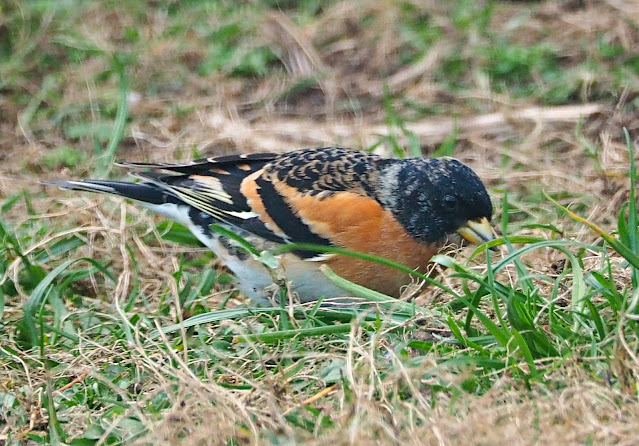There isn't much evidence of seasonal change on the bird front at the moment, well it's subtle. Two Brambling are hanging on in the garden, but the redpolls and the Goldfinch are now ensconced, stuffing their wee faces with Niger seed, at great expense I should add. I don't know why it's called Niger, other than it is black seed, apparently the seed of Guizotia abyssinica. Anyway, it's in the feeders for the Goldfinch and redpolls, crossbills quite like it, Greenfinch too, and Siskin. I put it on the ground for Brambling, a species which never goes to the Niger feeder, and I've only once, here, seen on the seed feeder.
 |
| Brambling, male. |
So far I've failed to attract a Hawfinch this spring, they tend to go for the bigger seeds. And I haven't been graced with Great Tit (ever) of which there have been several sightings across the county in the last few weeks.
In the rookery I can hear that the Rooks have fledglings, they've had them for about a week now. Hoodies are sitting in two territories and I'm guessing the other two pairs are thinking about it. The Pied Wags barely arrived and were straight into nesting. They're in one of the stone dykes near the house.
 |
| Pied Wagtail, male. |
Out on the coast my most "exciting" bird find was an oddly confiding Carrion Crow.
 |
| Carrion Crow, not a hybrid I would judge. |
The grey feathering that can be seen on the Carrion Crow above is not a sign that it is a hybrid, to my eye that's underfeathers, not sure of the technical term, but Carrions do have grey in the "base" layer. We have a crow passage through the isles at this time of year, most noticeably on North Ronaldsay, easier to record there. But quite often evident elsewhere in the county. Hoodies predominate but there are also, sometimes, quite substantial numbers of Carrions, and some hybrids with them. Not sure where they're going, perhaps younger birds dispersing northwards.
Also on the beach at Birsay there were still nine Snow Buntings, they should be gone fairly soon.
 |
| Snow Buntings. |
Spring was evidenced by Meadow Pipits all over the beach, and Pied Wagtails, with seven Wheatear and the regular build up of Mute Swans on the sea, 31 to be precise. A single Whooper lingered with them. Probably an ill or injured bird, in the past such individuals have summered.
 |
| Wheatear. |
Of course, I wasn't just birding on the beach. Much to the hound's annoyance I spent a lot of time turning stones, generally rather static. The stone turning didn't produce anything new, or at least nothing I wanted to take up the challenge of identification with, I ignored various small Diptera, spiders, mites and crustacea, although I recognise I may need to take some of these on in the future. Instead I was mostly beetling.
A couple of Cafius xantholoma, a nice Creophilus maxillosus which I don't find often in Orkney.
 |
| Creophilus maxillosus, easily recognisable in the field, I always think they look quite bee like, not at all like a Staphy. |
However, I did end up with a number of things in the pooter. Collembola and Staphys mostly. They may take a bit of doing with regard to ID but there were a good few of this small beetle which I didn't immediately recognise.
 |
| Cercyon littoralis. |
I should have seen this before, but I hadn't. I also should have realised what is was before I did, especially as I've recently keyed Cercyon melanocephalus, just for the hell of it, they're quite distinctive. So off I toodled through Unwin, going wrong, getting to Leodidae, trying to key through that before realising that I was hopelessly lost. However, my previous, recent Cercyon keying experience then came to my rescue as a vague memory of a mention at the beginning of the Cercyon key of seaweed/seashore inhabiting species tingled a ganglion or something. I dug out the Hydrophilidae key again, got successfully to Cercyon and... job done. In this last image you can see the distinctive pattern of the hind tarsi, No 1 (top) is long. So a water beetle on the shore, as is its previously mentioned congener a water beetle in the poo. Swimming through rotting kelp, or old cow dung, what a life!
In the pooter were more beetle key torture, well, I quite enjoy it, honest.




2 comments:
Aha! Creophilus maxillosus! Thank you! Megan found one the other day and we spent ages trying to figure out what kind of creature it was. Reckoned it was a beetle, but hadn't taken it any further.
Find them on the beach, look under dead things, or sometimes near wooden objects.
Post a Comment